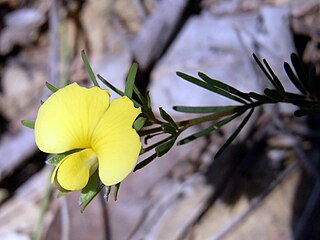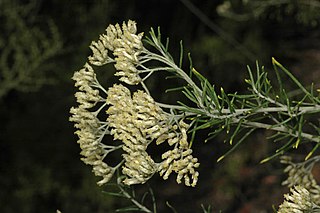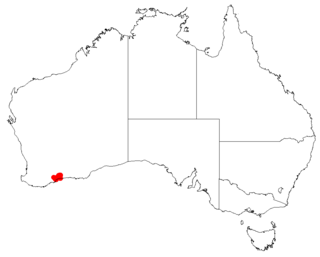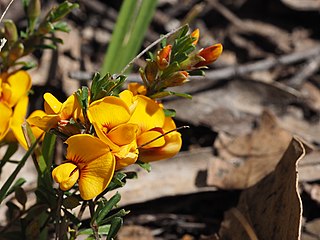
Dillwynia tenuifolia is a species of flowering plant in the family Fabaceae and is endemic to eastern New South Wales. It is an erect shrub with linear leaves, and orange-yellow and red flowers.

Olearia pimeleoides, commonly known as pimelea daisy-bush, is a species of flowering plant in the family Asteraceae and is endemic to southern continental Australia. It is an erect shrub with elliptic, linear or lance-shaped leaves, and white and pale yellow, daisy-like inflorescences.

Gompholobium glabratum, commonly known as dainty wedge-pea, is a species of flowering plant in the family Fabaceae and is endemic to south-eastern continental Australia. It is a low-lying or ascending shrub with pinnate leaves that have five to seven leaflets, and yellow and green or greyish flowers.

Mirbelia speciosa is a species of flowering plant in the family Fabaceae and is endemic to eastern Australia. It is an erect shrub with narrowly linear leaves arranged in whorls of three, and bluish-purple flowers usually arranged singly in leaf axils.

Cassinia uncata, commonly known as sticky cassinia, is a species of flowering plant in the family Asteraceae and is native to inland New South Wales and the south-east of South Australia. It is an erect shrub with hairy young stems, narrow linear to needle-shaped leaves, and heads of off-white to cream-coloured flowers arranged in rounded, almost conical panicles.
Persoonia rudis is a species of flowering plant in the family Proteaceae and is endemic to the south-west of Western Australia. It is an erect shrub with hairy young branchlets, linear leaves, and yellow flowers borne in groups of five to thirty on a rachis 3–100 mm (0.12–3.94 in) that continues to grow after flowering.

Persoonia dillwynioides, commonly known as Fitzgerald persoonia, is a species of flowering plant in the family Proteaceae and is endemic to a restricted area in the south-west of Western Australia. It is an erect, spreading shrub with smooth bark, linear leaves and bright yellow flowers borne singly or in groups of up to four along a rachis up to 3 mm (0.12 in) long.
Persoonia hakeiformis is a species of flowering plant in the family Proteaceae and is endemic to the south-west of Western Australia. It is an erect or spreading to low-lying shrub with mostly smooth bark, linear leaves and bright yellow flowers borne in groups of up to sixty along a rachis up to 100 mm (3.9 in) long.

Hovea chorizemifolia, commonly known as the holly-leaved hovea, is a species of flowering plant in the family Fabaceae and is endemic to the south-west of Western Australia. It is a small, upright shrub with prickly, green leaves and blue-purple pea flowers.

Dillwynia rudis is a species of flowering plant in the family Fabaceae and is endemic to eastern New South Wales. It is an erect shrub with warty, linear leaves and yellow to orange flowers with red veins.

Pultenaea aristata, commonly known as bearded bush-pea or prickly bush-pea, is a species of flowering plant in the family Fabaceae and is endemic to New South Wales. It is a small, erect shrub with linear to narrow elliptic, sharp-tipped leaves, and yellow and red flowers.

Pultenaea capitellata, commonly known as hard-head bush-pea, is a species of flowering plant in the family Fabaceae and is endemic to south-eastern continental Australia. It is a sprawling to prostrate shrub with elliptic to broadly egg-shaped leaves, and yellow to orange flowers with a red to purple keel.

Pultenaea echinula, commonly known as curved bush-pea, is a species of flowering plant in the family Fabaceae and is endemic to a small area of New South Wales. It is an erect shrub with linear, needle-shaped, grooved leaves, and dense clusters of yellow to orange and red flowers.

Pultenaea euchila, commonly known as orange pultenaea, is a species of flowering plant in the family Fabaceae and is endemic to eastern Australia. It is an erect shrub with glabrous foliage, narrow egg-shaped leaves with the narrower end towards the base, and orange-coloured flowers arranged singly or in small groups near the ends of branchlets.

Pultenaea microphylla is a species of flowering plant in the family Fabaceae and is endemic to eastern Australia. It is an erect to prostrate shrub with narrow egg-shaped leaves with the narrower end towards the base, and clusters of up to ten yellow to red flowers with reddish markings.

Bossiaea lenticularis is a species of flowering plant in the family Fabaceae and is endemic to eastern New South Wales. It is a slender, spreading shrub with mostly circular leaves, and yellow and red flowers.

Pultenaea parviflora, sommonly known as Sydney bush-pea, is a species of flowering plant in the family Fabaceae and is endemic to eastern New South Wales. It is usually a small, erect shrub with wedge-shaped to narrow egg-shaped leaves with the narrower end towards the base, and clusters of yellow to orange and red flowers.

Podolobium scandens, commonly known as netted shaggy-pea, is a flowering plant in the family Fabaceae and is endemic to eastern Australia. It is a prostrate, small shrub with orange-yellow pea-like flowers and red markings.

Gompholobium virgatum, commonly known as leafy wedge pea, is a species of flowering plant in the family Fabaceae and is endemic to eastern Australia. It is an erect or sprawling shrub with trifoliate leaves, the leaflets narrow egg-shaped with the narrower end towards the base, and yellow and greenish, pea-like flowers.
Pultenaea villifera is a species of flowering plant in the family Fabaceae and is endemic to two disjunct areas of Australia. It is an erect to prostrate shrub with triangular to linear, egg-shaped to elliptic leaves and yellow and red, pea-like flowers.


















